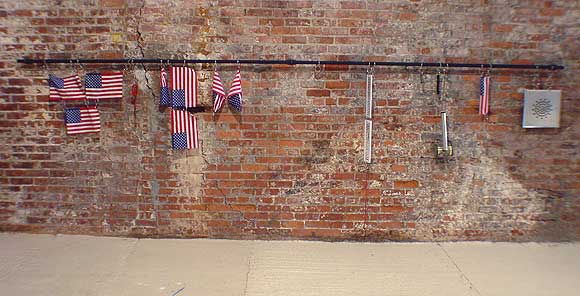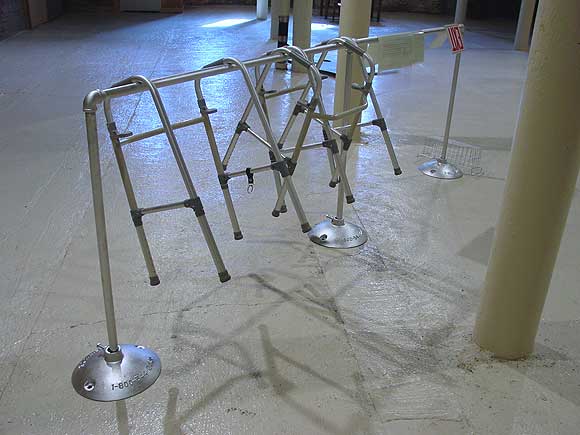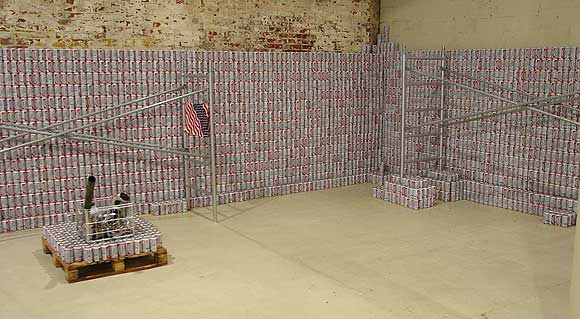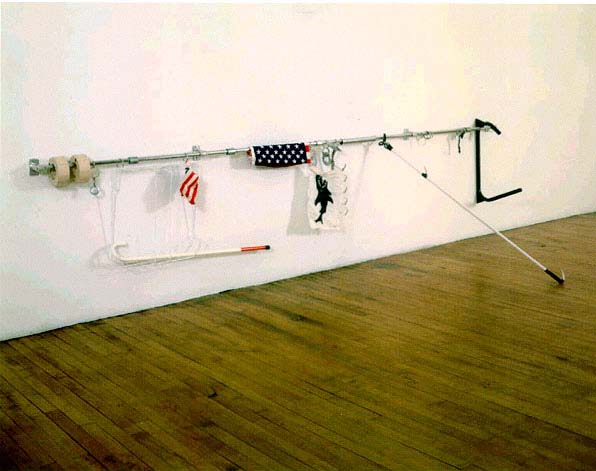


Not everything in Triple Candie's re-created Cady Noland show is so great--the strips of tape holding up the rather dog-eared Oozewald simulation are a poor substitute for thumbtacks (if that's what they originally were), and some of the fabrication looked amateurish, and not in a good way--but the above three pieces are superbly done, if superb is the right word. I took these photos yesterday--I actually saw something very close to the top two works (and met Noland) when she did a large-scale exhibition at the Dallas Museum of Art in '93, and can vouch that these versions are much like what I saw. Which is to say, offhand/slacker and fanatic/Judd/minimal at the same time. The main difference was--is this crucial?--no slick white gallery walls behind them, just Triple Candie's rough brickwork.
The show isn't just about creating a room of uncanny perfect copies, a la Sturtevant's Duchamps. It's also about whether recreating an art based on past ephemera is possible. And of course, whether the participation of the artist is essential in displaying work based on available materials. The artists have published detailed notes of how much or how little they were able to redo given their budget and the vagaries of finding (or re-finding) manufactured items from 20 years ago. They are completely up front in the press release that these pictures are based on, among other things, pictures on the Internet. In his hatchet job on the show, New York Times critic Ken Johnson doesn't mention that the Web was one of the sources used, thus writing out of history the rather important theme of how we rely on Google searches and cyber-facsimiles to give us our sense of history. It's quite possible that the photos above will show up in Google Images next to jpegs of actual Nolands. Is that good? Bad? Johnson doesn't go there.
An odd contradiction in Johnson's review: in the first paragraph he mentions that Triple Candie is a non-profit gallery, and then later says the show "might raise questions about art and commerce" (that is, if the gallerists didn't have such bad motives). He is projecting a set of intentions on them that differs from the ones they announced, and then slamming them for failing (or is it not failing?) to live up to them.
Just for the record, the re-creators are Taylor Davis, Rudy Shepherd and two anonymous artists. This post has been updated as new thoughts occur to me.
Update: Jerry Saltz also bashed the show. Typically, he describes many of the reasons it's interesting and then pronounces it shit. In this case, apparently based on loyalty to Noland and attachment to his memories of first encountering her work. He thinks she should sue the gallery--excuse me, "get a lawyer to get medieval on Triple Candie." He also passes along the insinuation that the gallerists are serially doing shows against artists' wishes, adding the unattributed anecdotal information (i.e., rumor) that David Hammons was "livid" about the show they did of his work. Not livid enough to stop the show in court, though. And is saying the artist didn't like the show the same as saying the gallerists "have gone around an artist's wishes," as Saltz does? As with Johnson, that's a nasty accusation to make without proof.
Update 2: This show is bringing out some conservative reactions in critics. Brian Sholis took the same protective line as Johnson. Like Saltz, he seems to think it threatens or cheapens Noland's legacy. But he hadn't seen the show when he wrote his post--he was reacting to the press release.
Update 3: As bill says, "Real or memorex?"

курсы английского технического языка
|
Not everything in Triple Candie's re-created Cady Noland show is so great--the strips of tape holding up the rather dog-eared Oozewald simulation are a poor substitute for thumbtacks (if that's what they originally were), and some of the fabrication looked amateurish, and not in a good way--but the above three pieces are superbly done, if superb is the right word. I took these photos yesterday--I actually saw something very close to the top two works (and met Noland) when she did a large-scale exhibition at the Dallas Museum of Art in '93, and can vouch that these versions are much like what I saw. Which is to say, offhand/slacker and fanatic/Judd/minimal at the same time. The main difference was--is this crucial?--no slick white gallery walls behind them, just Triple Candie's rough brickwork.
The show isn't just about creating a room of uncanny perfect copies, a la Sturtevant's Duchamps. It's also about whether recreating an art based on past ephemera is possible. And of course, whether the participation of the artist is essential in displaying work based on available materials. The artists have published detailed notes of how much or how little they were able to redo given their budget and the vagaries of finding (or re-finding) manufactured items from 20 years ago. They are completely up front in the press release that these pictures are based on, among other things, pictures on the Internet. In his hatchet job on the show, New York Times critic Ken Johnson doesn't mention that the Web was one of the sources used, thus writing out of history the rather important theme of how we rely on Google searches and cyber-facsimiles to give us our sense of history. It's quite possible that the photos above will show up in Google Images next to jpegs of actual Nolands. Is that good? Bad? Johnson doesn't go there.
An odd contradiction in Johnson's review: in the first paragraph he mentions that Triple Candie is a non-profit gallery, and then later says the show "might raise questions about art and commerce" (that is, if the gallerists didn't have such bad motives). He is projecting a set of intentions on them that differs from the ones they announced, and then slamming them for failing (or is it not failing?) to live up to them.
Just for the record, the re-creators are Taylor Davis, Rudy Shepherd and two anonymous artists. This post has been updated as new thoughts occur to me.
Update: Jerry Saltz also bashed the show. Typically, he describes many of the reasons it's interesting and then pronounces it shit. In this case, apparently based on loyalty to Noland and attachment to his memories of first encountering her work. He thinks she should sue the gallery--excuse me, "get a lawyer to get medieval on Triple Candie." He also passes along the insinuation that the gallerists are serially doing shows against artists' wishes, adding the unattributed anecdotal information (i.e., rumor) that David Hammons was "livid" about the show they did of his work. Not livid enough to stop the show in court, though. And is saying the artist didn't like the show the same as saying the gallerists "have gone around an artist's wishes," as Saltz does? As with Johnson, that's a nasty accusation to make without proof.
Update 2: This show is bringing out some conservative reactions in critics. Brian Sholis took the same protective line as Johnson. Like Saltz, he seems to think it threatens or cheapens Noland's legacy. But he hadn't seen the show when he wrote his post--he was reacting to the press release.
Update 3: As bill says, "Real or memorex?"
- tom moody 5-14-2006 9:16 am
курсы английского технического языка
- DonaldEtelt (guest) 4-07-2023 8:21 am